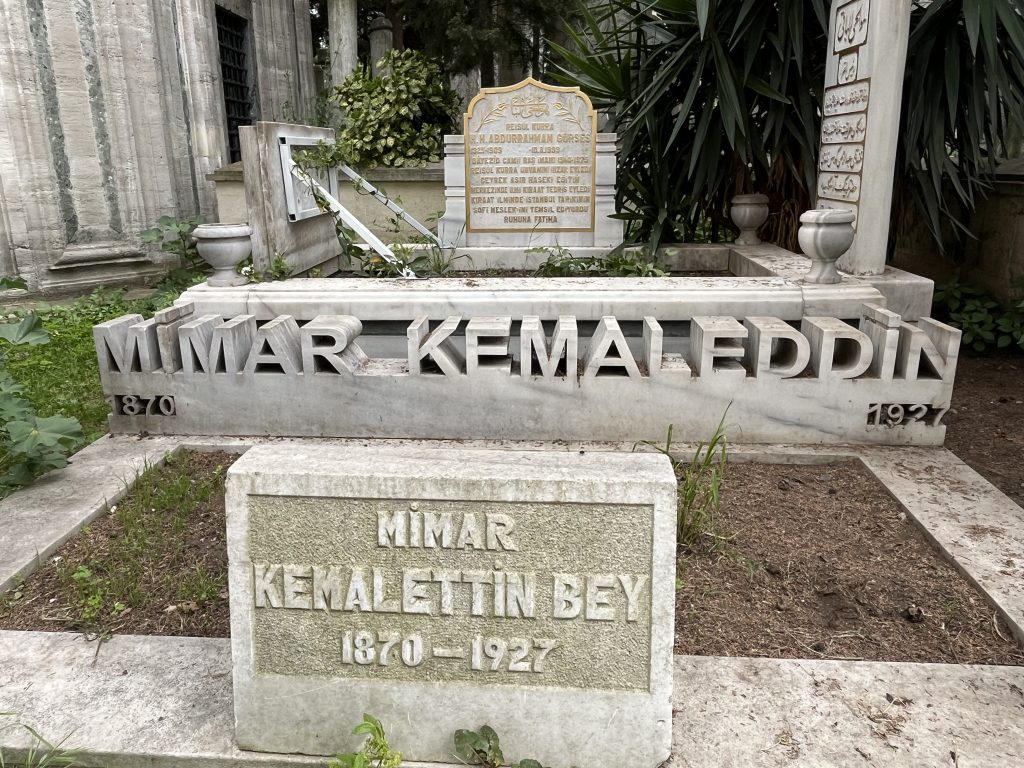
Born in Istanbul, Ahmed Kemaleddin Bey (1870-1927) was, with Vedat Tek, a founding father of the Birinici Ulusal Mimarlık (First National Architecture) movement. Trained as an engineer as well as an architect, Kemaleddin Bey studied under August Jasmund and went on to collaborate with Vedat Tek in developing a more pared-down style of architecture that still drew on Selçuk and Ottoman motifs. At times he also incorporated elements taken from Art Nouveau into his work. Compared with Tek’s, his work tends to be more austere with less use made of tiles on facades, for example, although the tomb he designed for Mahmud Şemsi Paşa beside the Abide-i Hürriyet is highly decorated. Like Tek, he designed a number of buildings for the rapidly expanding business district of Sirkeci-Eminönu but, unlike Tek, he also designed a number of tombs for the area around Eyüp.
As well as being an architect, Kemaleddin Bey was a restorer of historic buildings, including the Hünkar apartments attached to the Yeni Cami in Eminönü and the Fethiye Cami in Karagümrük. Unlike Vedat Tek, he carried out much of his work abroad, for example at the al-Aqsa mosque in Jerusalem. Kemaleddin Bey seems to have died of a heart attack on the site of the Ankara Palas which still exhibits the turrets that were one of his trademarks. He was originally buried in the Karacaahmet Cemetery before being re-interred in the grounds of Beyazıt Cami. His portrait appears on the reverse of the TL20 banknote.
- Ahmed Cevad Paşa tomb, Fatih
- Ankara Palas (started by Vedat Tek)
- Bebek Cami, İstanbul
- Bostancı Cami, İstanbul
- Çamlıca Girls’ High School, İstanbul
- İlk Mektebi, Denizli
- Edirne Railway Station, Karaağac
- First Vakıf Han, Eminönü, İstanbul (also Second and Third Vakıf Hans, since lost)
- Fourth Vakıf Han, now Otttoman Legacy Hotel, Eminönü, İstanbul
- Gazi Osman Paşa tomb, Fatih Cami, İstanbul
- Haydar Çavuş Cami, Bandırma
- Hüznü Paşa tomb, Eyüp
- Kamer Hatun Cami, Tepebaşı
- Mahmud Şemsi Paşa tomb, Mecidiyeköy, İstabul
- Reşadiye Primary School, Eyüp, İstanbul
- Sultan Mehmed Reşad tomb, Eyüp, İstanbul
- Tayyare (Harikzedegan) Apartments, now Crowne Plaza Hotel, Laleli, İstanbul
- Yeşilköy Cami, İstanbul



